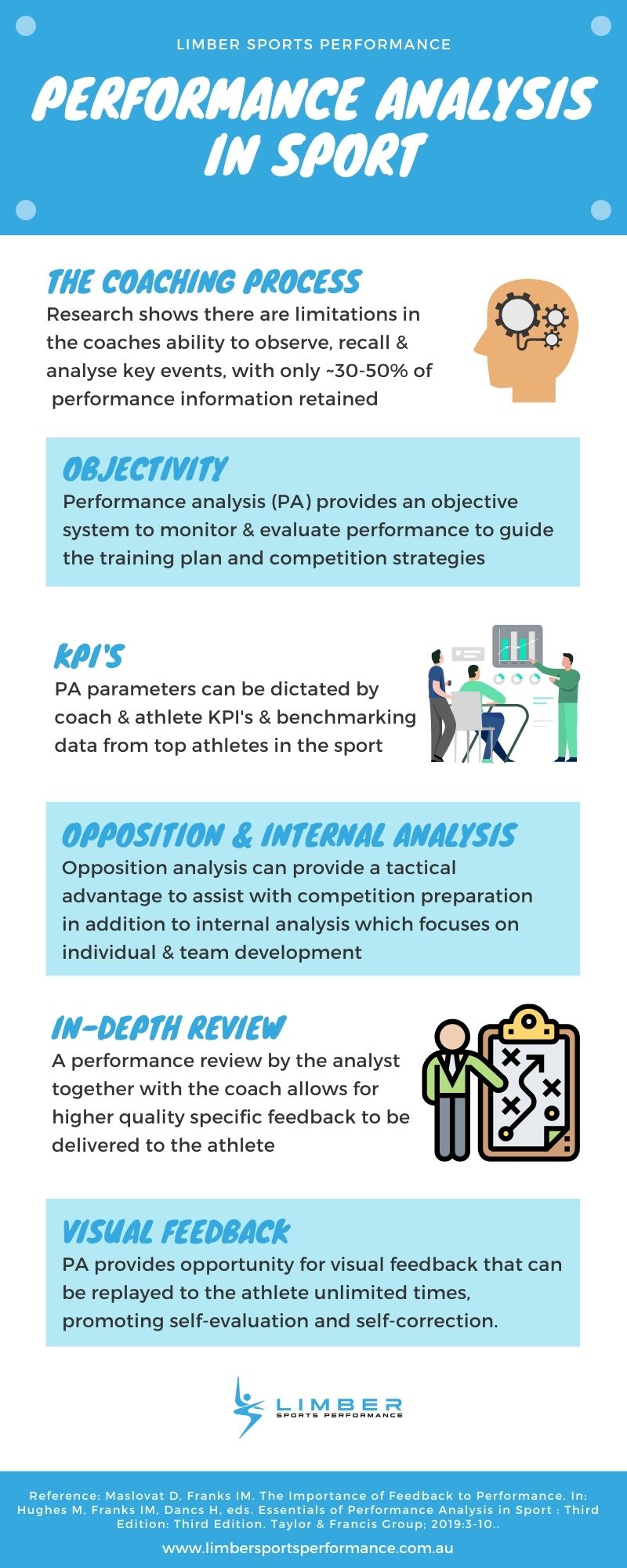Performance Analysis in Sport
Performance analysis may seem like it’s own unique area of Sports Science but the more you learn about it, the more you realise its integral role in the coaching and feedback process, goal setting and athlete benchmarking, tactics, biomechanics, load monitoring, injury prevention and visualisation techniques. This infographic provides a brief introduction into the theoretical rationale for the use of performance analysis in sport.
The Role of Feedback in Skill Development
Feedback is an essential component of learning and refining a sports skill. An athlete can make use of both intrinsic feedback from their own sensory channels and extrinsic feedback from an outside source such as a coach. Intrinsic feedback can be received through sight, such as how the ball looks on release, or feel, how it felt performing the skill. With experience even more detailed feedback such as coordination of joint activity can be used by the athlete. Extrinsic feedback complements intrinsic feedback by helping the athlete to compare what was done to what was expected. The coach can use their experience to bring the performers attention to a key area of performance (eg: insufficient rotation) which caused the result.
Coaching Feedback
The coaching process involves a complex and continuous cycle of performance analysis and feedback. The coach observes and analyses athlete performance and combines this information with observations and knowledge of previous performances. The coach consequently provides feedback to the athlete and adjusts the training plan accordingly. Therefore, the success of the coaching process relies on the accuracy and scope of the performance analysis process to guide future practice.
The Human Information-Processing System
If the performance analysis process is going to guide athlete feedback and development, we need a system as objective, unbiased and comprehensive as possible. Therefore, can we really rely purely on coaches’ observations? In fact, we know that human memory has several limitations and it’s almost impossible for coaches to follow an entire playing area or remember all the events that take place in a sport. Even International coaches may only recall up to 30% of key factors, with many inaccuracies documented, even in the case of note taking. Coaches recall of events can be influenced unknowingly by their motives and beliefs, for example whether they believe an athlete is usually competent or consistent in the skill they performed. Coaches’ perception of events can also be selective as they may have been focussing attention on a particular area of the sports field or court and missed important peripheral action taking place. Therefore, even an experienced coach can be left with an incomplete picture and distorted perception of an event.
How Performance Analysis Can Fill the Gap
With advances in technology, video analysis systems are able to collect and store vast amounts of information that can be replayed unlimited times. Identifying and coding key events provides a picture of what happened, and patterns associated with winning and losing. This reduces observer bias and allows a visual image of the event to be processed by the athlete. Effective presentation of video feedback tends to include cueing from the coach on which features of a movement to focus on, eg: “focus on the follow through after release.” Video editing and use of slow motion can further enhance the feedback process to highlight detail which would be missed by the human eye. Some coaches even involve the athlete in the analysis process to improve their error detection and self-correction mechanisms. Using players in the notation process can enhance their understanding of their sport and provide them with the statistics directly – food for thought!
Video analysis isn’t just useful in identifying errors. Did you know observing an image or video of a correct performance stimulates brain activity similar to performing the movement itself? Therefore, presenting the athlete with a visual of ideal performance (ideally performed by themselves or if not another athlete) is a useful feedback tool.
What Methods of Analysis Exist?
Notational Analysis
Notational analysis involves recording critical events that occur in performance that become indicators of good or bad team performance and highlight the contributions of individual players to the result. It also allows comparative analysis between teams and players and can help assess the physiological and psychological demands of the sport. Notational analysis can be used for the purpose of either tactical, technical or movement analysis.
Tactical analysis revolves around collecting data about play patterns as well as descriptive match data. Tactical analysis assists to identify successful performance indicators in sport. For example, comparing the patterns of play of winning versus losing teams or players in competition. In tennis this has been used to compare which patterns of play are more successful on the different court surfaces. It is important to note that tactical models must be updated over time as the pace of play changes and equipment evolves.
Technical Analysis from notation may include a ratio of goals kicked versus attempts in AFL or the number of first Serve’s won in Tennis. When done comprehensively technical analysis can identify skill weaknesses to address in training. With technical analysis the more information taken into account the more useful the information. If number of successful goals is the indicator, then there should be a factor of difficulty integrated – for example was the shot directly in front of goal, was it outside 50 m?
Movement analysis can involve modern tracking systems to track players gross movements across the playing area, work rate and distance covered during an event. This can help identify physiological demands of the sport and fitness requirements which should be prepared in pre-season.
Biomechanical Analysis
In contrast to the gross movement patterns identified in notational movement analysis, biomechanical analysis is associated with the fine detail in a technical sports skill. Biomechanics identifies aspects of performance associated with good or bad technique to highlight areas for improvement. It can also be used to identify injurious techniques which should be corrected. For example, thanks to biomechanics a link was identified with mixed technique cricket bowling and low back injury.
Summary
This was just a brief introduction into some of the benefits and uses of performance analysis. Pairing experienced coaching with objective data is a mean recipe for sporting success. Performance analysis strengthens the coaching process bringing certainty to the coach and athlete as to their immediate focus and future direction.
If you would like to learn more specifics about how performance analysis can help your sport, get in touch with Shane from Data Driven Analytics – as he would say “The numbers don’t lie.”
References
Maslovat D, Franks IM. The Importance of Feedback to Performance. In: Hughes M, Franks IM, Dancs H, eds. Essentials of Performance Analysis in Sport: Third Edition : Third Edition. Milton, UNITED KINGDOM: Taylor & Francis Group; 2019:3-10.
Hughes M, Barlett R. What is Performance Analysis. In: Hughes M, Franks IM, Dancs H, eds. Essentials of Performance Analysis in Sport: Third Edition: Third Edition. Milton, UNITED KINGDOM: Taylor & Francis Group; 2019:11-20.

